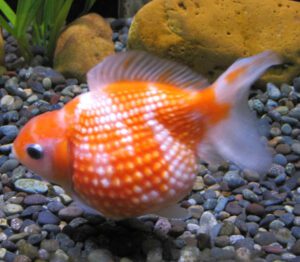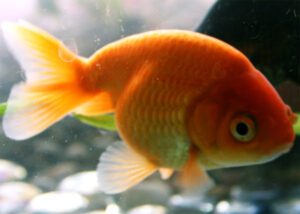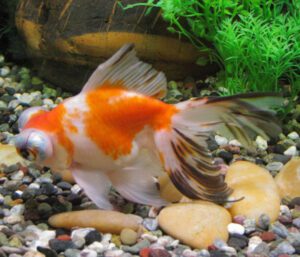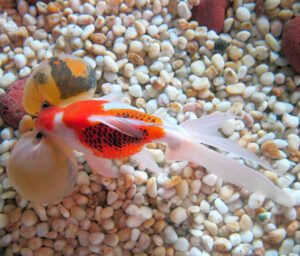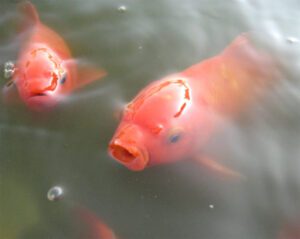The Goldfish is one of the most commonly kept aquarium fish in the world. It is a freshwater fish in the family Cyprinidae of order Cypriniformes. It is comparatively a small member of the carp family. And it is native to east Asia. This species was first selectively bred in China more than a thousand years ago. And several other distinct breeds have been developed since then. Various species of carp fish which are collectively known as Asian carp have been bred and reared as food fish for thousands of years.
Some of these general gray or silver colored species have a tendency to produce red, orange or yellow color mutations. And this was first recorded during the Jin dynasty (265-420). It was popular to raise in ornamental ponds and watergardens during the Tang dynasty. A natural genetic mutation produced gold rather than silver coloration. And people soon began to breed the golden variety instead of the silver variety in ponds or other bodies of water. The selective domestic breeding of goldfish was firmly established by the Song dynasty (960-1279).
The Goldfish were highly regarded in southern Europe during the 1620s mainly because of their metalic scales, and symbolised good luck and fortune. In some areas it became a tradition for married men to give their wives a Goldfish on their fist anniversary, as a symbol for the prosperous years to come. But this tradition died quickly, because Goldfish became more available and loss their status.
These fish were first introduced to North America around 1850 and became popular quickly in the United States. Read some more information about this fish species below.

Goldfish Physical Characteristics
The Goldfish breeds vary greatly in size, fin configuration, body shape and coloration. Their body coloration are various combinations of white, orange, yellow, brown, red and black are known. The wild populations vary in color from gold to olive green or even creamy white. They generally have an elongated, stocky body and not all the individuals have the well-known bright gold color.
The Goldfish generally have two sets of paired fins- pelvic fins and the pectoral fins. And have 3 single fins- the dorsal fin, anal fin and caudal fin. They have no scales on their head, and they also lack barbels on the upper jaw. They generally have exceptionally large eyes and acute senses of smell and hearing. There are 27-31 scales along their lateral lines.
The Goldfish have pharyngeal teeth rather than true teeth in their throats which they use for crushing food. Average body length of the mature fish is between 12 and 22 cm with a maximum recorded body length of 45 cm. And maximum recorded weight of the mature fish is 3 kg.

Diet
The wild Goldfish are omnivores and eat plants, insects (such as mosquito larvae), zooplankton, detritus and small crustaceans. But they are generally fed dried flake or pellet food in captivity. Freeze dried Tubifex worms, bloodworms, Daphnia, mosquito larva, brineshrimp and vegetation (such as boiled peas and lettuce) are good supplements for these fish.
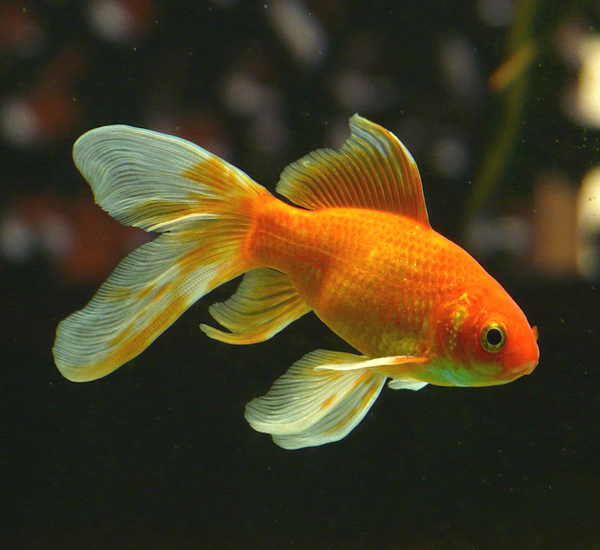
Reproduction
The Goldfish may only become mature for reproduction with enough water and the right nutrition. Most of these fish generally breed in captivity, particularly in pond settings. Breeding of these fish generally happens after a significant temperature change, often in spring. The Goldfish are egg layers, like all cyprinids. Their eggs are adhesive and attach to aquatic vegetation, generally dense plants such as Elodea or Cabomba or a spawning mop.
The males actually chase gravid female and prompt them to release their eggs by bumping and nudging them. The eggs generally hatch within 48 to 72 hours.

Uses
Currently the Goldfish is used and valued as ornamental fish for aquarium and ponds. It is edible but rarely eaten or used for food. It is also used as an experimental species.
Special Notes
Particularly the Goldfish are not aggressive, and combining sizes is not often a problem. They will school to a certain extent in the wild, but can be kept separately in bowls or aquariums. They generally can be found in slow-moving and freshwater bodies of water in the wild. They can also thrive in slightly sludgy water, live their close relative the carp.
They can thrive in a pond environment. But in case of raising them in aquarium, bi-weekly water changes are good idea, because their tank is hard to keep clean. The Goldfish are long-lived fish species. Their average lifespan is around 10 years in aquarium, with a maximum reported lifespan of a pet Goldfish is 25 years.

Currently Goldfish farming has become an industry of notable size. Millions of fish are bred each year and sold to aquarium shops for resale to fish enthusiasts. There is a demand for this fish in North America to be used as bait by anglers. Pet shops often have feeder Goldfish to sell to owners of carnivorous aquarium fish. Although these fish are often considered as pests in some places where they have been introduced. However, review full breed profile of the Goldfish in the table below.
| Name | Goldfish |
| Kingdom | Animalia |
| Phylum | Chordata |
| Class | Actinopterygii |
| Order | Cypriniformes |
| Family | Cyprinidae |
| Genus | Carassius |
| Species | C. auratus |
| Binomial Name | Carassius auratus |
| Other Names | None |
| Breed Purpose | Mainly pet |
| Special Notes | Not aggressive, combining with other fish species is not a problem, generally can be found in slow-moving and freshwater bodies of water in the wild, can also thrive in slightly sludgy water, can thrive in pond environment, long lived fish species, 10 years of average lifespan with a maximum recorded lifespan of 25 for pet fish, considered as pests in some places |
| Weight | Maximum recorded body weight is 3 kg |
| Breeding Method | Generally breed in captivity, particularly in pond settings |
| Climate Tolerance | Almost all climates |
| Body Color | Many |
| Rarity | Common |
| Availability | Worldwide, but mainly Asia |
Frequently Asked Questions
Can goldfish live in tap water?
Yes, they can live in tap water. But you have to treat the water properly to remove harmful chemicals. In most cases, they can not live in untreated tap water.
How long should goldfish live?
Depends on numerous factors. But average lifespan of a goldfish is around or upto to 10-15 years, with some varieties living up to 30 years.
Do goldfish get lonely?
No, they don’t in most cases. You can keep a single or only a few goldfish in your tank.
What does a goldfish eat?
Ready made, commercial feeds are available in the market for these fish. And such commercial feed is a mixture of specialized goldfish flake and granules.
How often do you change goldfish water?
We generally change water once a week. And sometimes once in 15 days.
What size tank do you need for 2 goldfish?
You will need a 20 gallon tank for raising 2 goldfish.
How long can goldfish go without food?
Goldfish can go without food for 8 to 14 days.
Can I feed my goldfish banana?
Yes, you can feed your goldfish with banana and many different vegetables like peas, spinach, kale etc. And some fruits which are good for these fish include apple, orange, watermelon, grapes etc.
What fish can not live with goldfish?
You should not keep any large cichlids or aggressive barbs with your goldfish.
Do goldfish recognize their owners?
Yes, they often recognize the human that regularly feeds them.
Can you transfer goldfish from tank to pond?
Yes, sure! You can safely move your goldfish from a tank to a pond.
Do goldfish need darkness to sleep?
Yes, they do sleep better when it’s dark and quiet.
How big do goldfish get?
Depends on numerous factors. Generally, the goldfish often reach 12-14 inches length in the wild.
How often do you feed a goldfish?
You can feed these fish twice or thrice a day.
What are the main characteristics of a goldfish?
Goldfish have two sets of paired fins and three sets of single fins. They don’t have barbels, sensory organs some fish have that act like taste buds. Nor do they have scales on their heads. They also don’t have teeth and instead crush their food in their throats.

